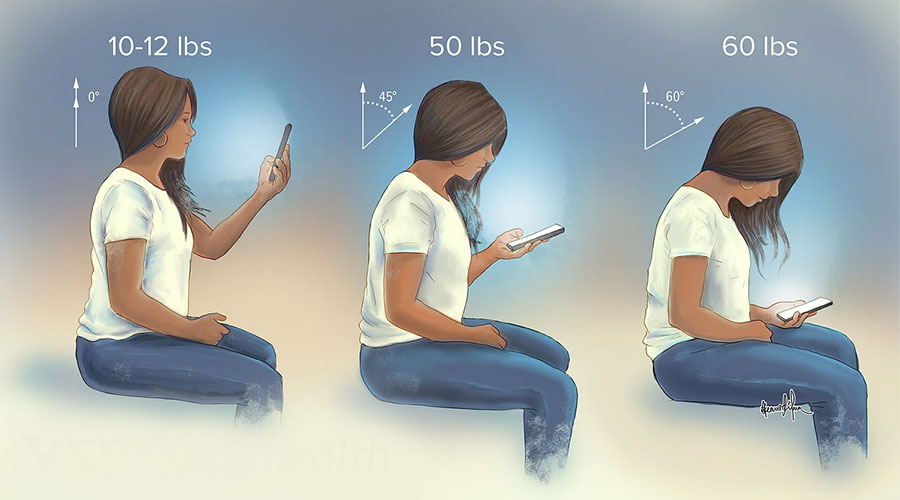ASK A PHYSICAL THERAPIST
- 20 Apr - 26 Apr, 2024

Ans: Well, it seems that he is having a forward head posture. It is a poor posture that becomes habitual in patients and leads to various issues. In addition to forward head, it is also characterised by rounding of shoulders that is also known as slouching of shoulders and upper back rounding. When muscles remain in a poor position, they become tight as well as shortened and this posture can cause muscular issues in the back and neck as well as cause compression in the neck. The posture can lead to neck pain, headache, back pain, chest pain, numbness and tingling in the arms and hand due to compression. It is a very common practice by the patients to take medications like pain killers to ease the pain, but it is necessary to address the underlying issue that is causing pain and discomfort. The use of painkillers makes the pain go away as it is not felt by the patient. However, the issue remains as it is without being properly addressed. The causes include the use of smart phones, ergonomic issues at workplaces like computer or table height, keeping the head in elevation by using double pillows during sleep, poor back postures, poor muscle strength. This faulty posture can cause muscle shortening that causes reduced blood flow in the muscles causing fatigue and pain, reduction of range of motion in the neck, occurrence of early degenerative changes in the neck spine, disc degeneration, spur formation or extra bone growth in spine, jaw pain can also occur. Tension headaches can occur in the patients and there can also be reduction in the range of motion of the arm and shoulder, there is risk of nerve compression, thoracic muscular impairment can also occur that can lead to respiratory problems. A physical therapist observes and assesses the patient for the diagnosis and can also order radiographs if required. Physical therapy treatment includes pain management, muscle relaxation, postural alignment, increase in the range of joints and increasing flexibility, ergonomic adjustment, increase in the strength of the muscles.

A: The text neck syndrome is a faulty posture like forward head posture but the difference is that the cervical spine (neck) is flexed and not extended in text neck syndrome. It is an overuse condition and occurs when the neck muscles get strained while continuously looking at the smart phone or any other device with neck flexion. It can either be habitual or related to any ergonomic issue. It can lead to a number of complications like headaches, back pain, respiratory issues, arm pain, neck and shoulder pain. It is a common condition in teenagers as well as adults. The posture is faulty and can cause neck spine inflammation; there are muscles, ligaments, nerves etc in the cervical or neck region. Early arthritic changes can occur in the spine that include degeneration of the disc, spur or extra bone growth at the edges of the vertebrae and stenosis or reduction in the space from where the nerve is leaving the spine. It is necessary to treat the condition as early as possible as it can lead to neck stiffness, radiating pain and reduced muscle strength in patients. A physical therapist assesses the patient and designs rehabilitation which includes modalities, muscle relaxation and strengthening exercises. It is necessary to avoid continuous and prolonged posture assumption and rest should be added by breaking the work duration, prolonged static posture should be avoided, there should be no heavy object in hands while using and proper positioning of the devices should be ensured.
A: The abnormal clenching of teeth is known as “Bruxism”. The patient may clench the teeth while sleeping or awake. The condition is having various psychosocial factors like stress, anxiety etc, people having sleep disorders may also have this condition. Patients may report gum disorders, sensitivity, tenderness at the muscles of the jaw that help in chewing, teeth issues, headache, jaw locking, jaw pain, jaw clicking etc. It is important to consider the case with consideration of all the associated factors and a team work of professionals. A physical therapist assesses the jaw and the neck in addition to the posture of the patient. In addition to using specialised techniques, If the patient’s bruxism is occurring during the day then education and advice is needed to help change habits such as nail biting, pencil chewing and jaw clenching which is also a form of bruxism. Helping patients to identify and address stressors in their daily life can be helpful. In some cases patients may benefit from relaxation therapy, breathing training and exercises. Referral to a psychologist may help some patients.
It is necessary to improve sleep, the environment can be adjusted and a proper routine needs to be set. The patient may need referral if there is a sleep disorder like sleep apnea. A dentist can also help in this regard, some patients wear mouth guards or splints to avoid clenching or grinding. This reduces the compression of the temporomandibular joint (TMJ) or jaw and may also reduce long-term damage to the teeth.
COMMENTS